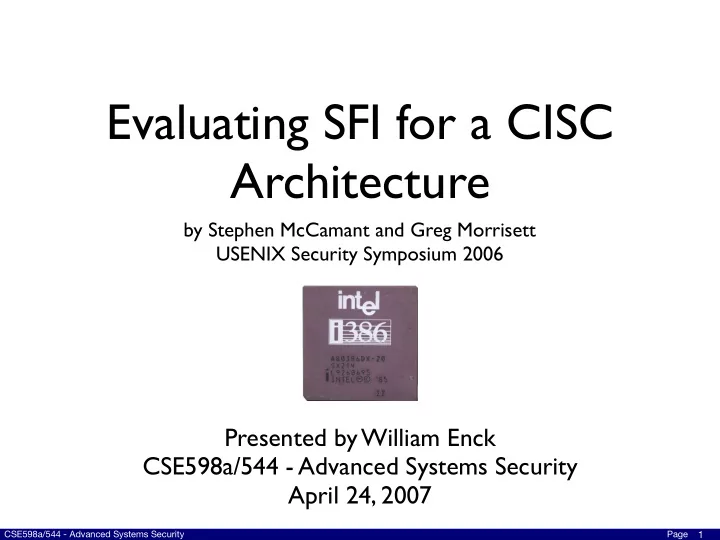

Evaluating SFI for a CISC Architecture by Stephen McCamant and Greg Morrisett USENIX Security Symposium 2006 Presented by William Enck CSE598a/544 - Advanced Systems Security April 24, 2007 CSE598a/544 - Advanced Systems Security Page 1
A Reoccurring Topic • Today’s topic: Buffer Overflows 0xFF...FF Top of Stack ‣ Why do we keep talking about them? ... ‣ A quick review of malcode prevention: Return Address Stack Growth Buffer Growth • Sandboxing variables buffer[n-1] • Syscall IDS buffer[...] • Randomization buffer[0] ... • Canaries 0x00...00 • etc. • We are not going to talk about buffer overflows per se, rather another technique that can help stop attacks, one of which is buffer overflows CSE598a/544 - Advanced Systems Security Page 2
A Practical Approach • A Two-Step Process ‣ Rewrite application binaries • Consume assembly code (this is not a compiler trick) ‣ Verify the rewrite was successful • can be done at load time “We do not mind if the verifier fails to recognize that some programs have the safety property, as long as whenever it concludes that on does, it is correct.” CSE598a/544 - Advanced Systems Security Page 3
Software Fault Isolation • Basic idea: prevent potentially unsafe instructions from executing with improper arguments ‣ down to the granularity of memory writes “SFI does not provide general protection against attacks on the untrusted code; it simply contains those attacks within the component” • How do the goals differ from other techniques? • Limitations: ‣ Typically slow ‣ CISC is tough CSE598a/544 - Advanced Systems Security Page 4
The x86 Architecture • You can’t live with it, you can’t live without it ‣ x86 is the de-facto standard that is not going away • CISC Architectures have: ‣ instructions vary in length • RISC typically has a “4-byte stream” ‣ small number of registers • Previous SFI techniques required five CSE598a/544 - Advanced Systems Security Page 5
Normalizing CISC • Instruction “streams” are used by previous SFI techniques to verify branch target addresses • CISC has variable length instructions ‣ add “ nop ” padding to recreate sanity • no instruction crosses the 16-byte chunk boundary • The start of every 16-bytes is an instruction (“psuedo-stream”) ‣ What is the cost of this addition? • Largest percentage of performance overhead • From a storage perspective, binaries increase by 50-100% (but easily compressible) ‣ No one ever said security was free CSE598a/544 - Advanced Systems Security Page 6
Efficient Protection • Make use of architecture and implementation specifics ‣ Use as few “special” registers as possible ( %ebp ) ‣ Smart memory range checking • Frame pointer ( %ebp ) only set at start of function ‣ check on set • Stack pointer ( %esp ) frequently modified ‣ This one is a little more tricky (problematic in related work) ‣ check before jump ‣ Efficient address “checking” with bitwise and • code regions with simple higher order bits • use mask to ensure the address is where you want it to be ‣ Modern x86 processors keep shadow stacks for branch prediction, therefore, we want to keep ret instructions CSE598a/544 - Advanced Systems Security Page 7
Formal Analysis • Not something you see every day • The ACL2 theorem-proving system acts on Lisp implementations of a model system ‣ Implemented an x86 simulator ‣ Proves verifier achieves safety goals • The rewriter was not analyzed CSE598a/544 - Advanced Systems Security Page 8
Back to Buffer Overflows • What does all of this do for buffer overflows? ‣ Binaries verified to provide fault containment ‣ The verifier has been verified ‣ They solved buffer overflows, right? • Is the model correct? • Is containment the answer? ‣ Does this work for real programs? • Apache, Bind? OpenSSH? CSE598a/544 - Advanced Systems Security Page 9
Take-away • A lot of interesting optimizations have been applied to make a previously discounted idea applicable to real systems • Knowing what an arbitrary program will do is impossible; ‣ however, it may be good enough to be sure that a program with specific properties will act in specific ways. CSE598a/544 - Advanced Systems Security Page 10
Recommend
More recommend